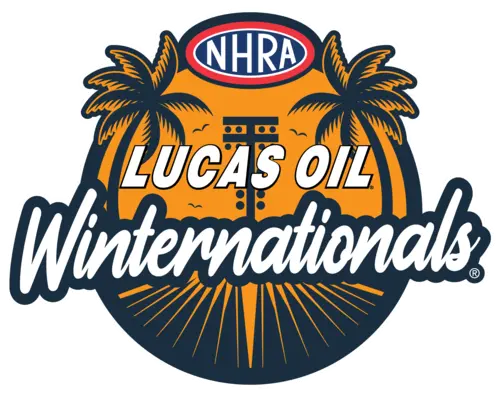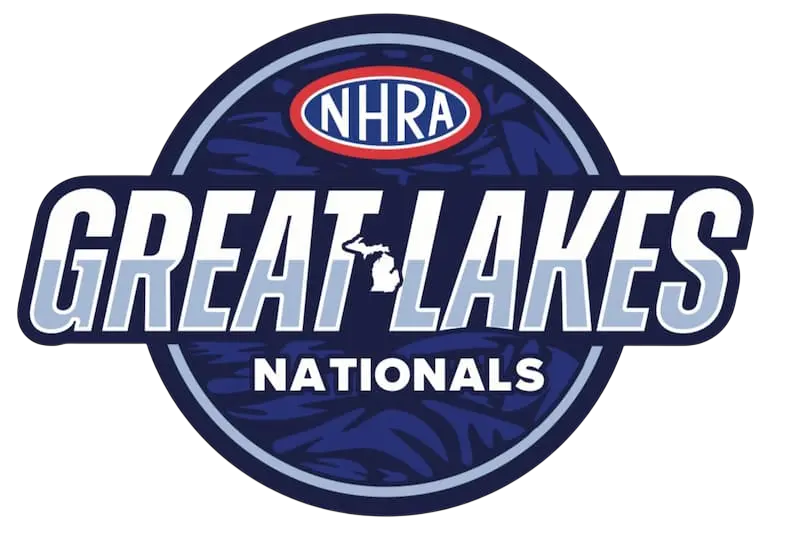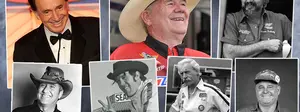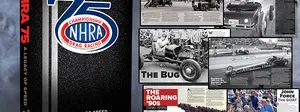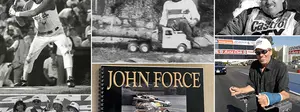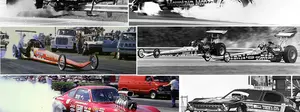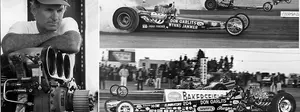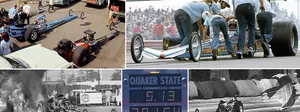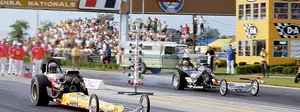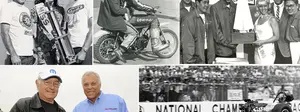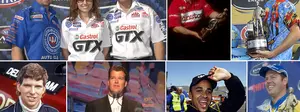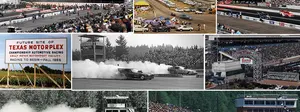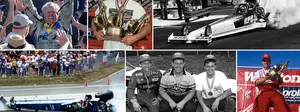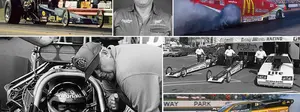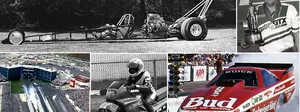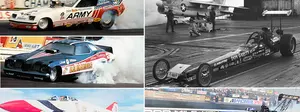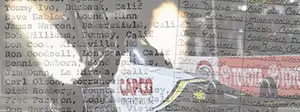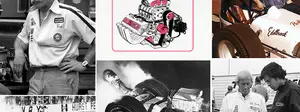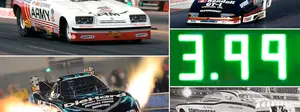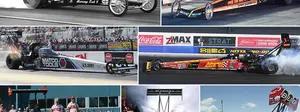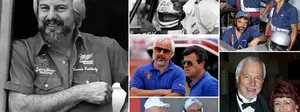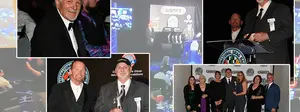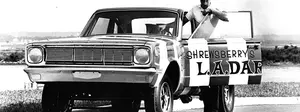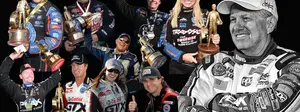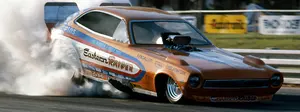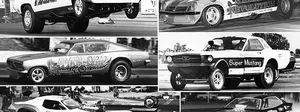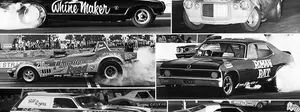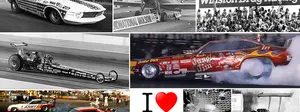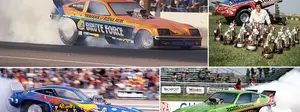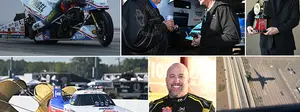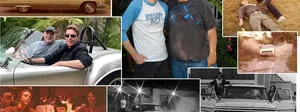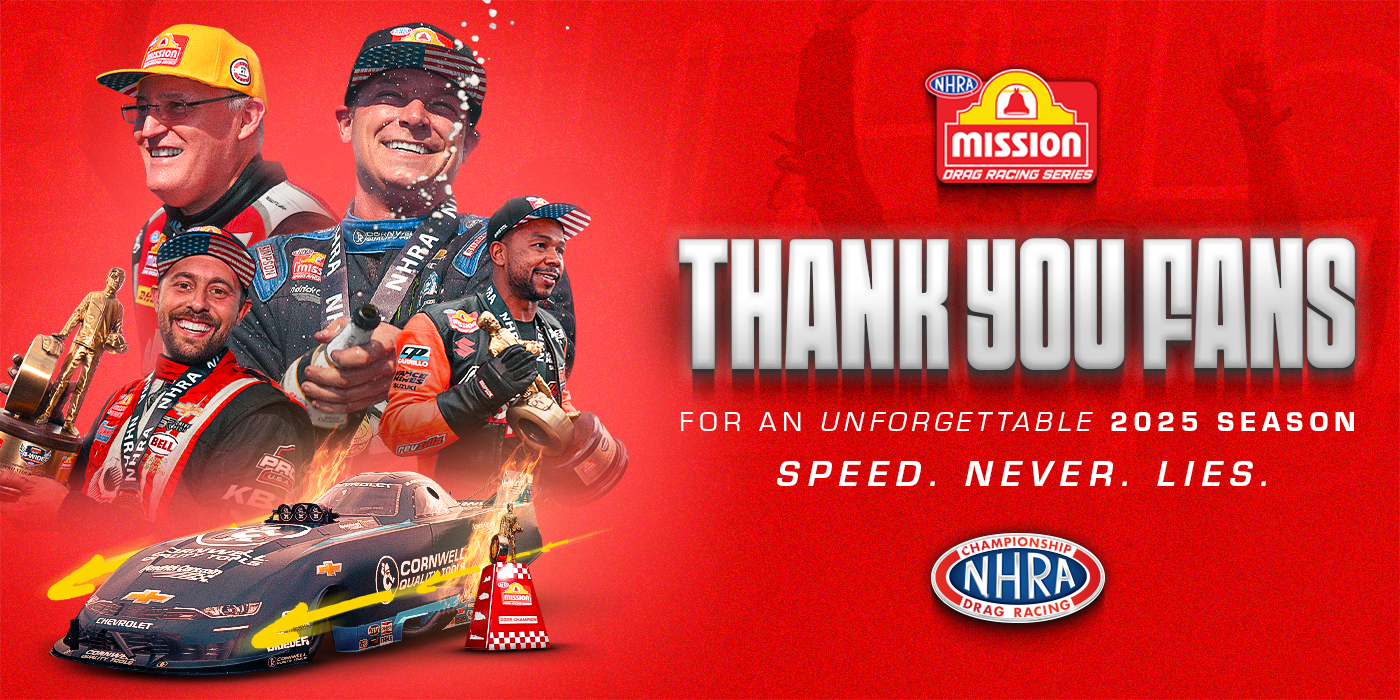

Touching moments, toppled Trees, and fond farewells
After covering 14 national events in 19 weeks, we get a little breather this week, at least on the Mello Yello side, which conveniently will allow me to catch up on overdue business here from the last several columns. I didn’t travel to them all (only half), but that’s enough time in airports, rental cars, and hotels to slow my roll. I get so many wonderful emails from the Insider Nation that I can’t possibly respond to or include all of them in this column, but know that every bit of information, acknowledgment, and thanks is very much appreciated.
It’s gonna be a long one, so grab a cup (or bottle or can) of your favorite beverage, put your feet up, and enjoy. Here we go …

Mike Goyda, left, with Don Roberts and the Jade Grenade cowl
|
Last November, during the thread about bits and pieces of crashed race cars that were in people’s collections, I shared the story of how collectibles king Mike Goyda owned the cowl from the Jade Grenade Top Fueler that Don Roberts crashed at New England Dragway in 1975. Because I’m friends with both, I forwarded a pic of the cowl to Roberts.
Once Goyda learned that Roberts had lost a leg in the crash, he generously offered to loan the cowl to Roberts for as long as he wanted it. Roberts was touched but declined. The two got together a few weeks ago at – fittingly -- New England Dragway during the NHRA Motorsports Museum New England Hot Rod Reunion presented by AAA Insurance after photographer Mike McCarthy put them together for the photo at right.
“Despite the rain, the event was great, but this moment with Don was the highlight of the weekend for me,” said Goyda.
Roberts, who was honored at the event with an NHRA Lifetime Achievement award, also will never forget the reunion. “I was touched when Mike pulled it out of his van, and what really floored me was Mike was very emotional about the whole situation himself,” he said. “Mike is a wonderful man, and I sincerely appreciate him thinking of me. I am so proud of [the award] and still blown away by the wonderful weekend we had. I never thought anyone paid much attention to what I was doing so long ago, but I am so glad someone did.”
Me, too! What a great story and a wonderful example of the kinship of the drag racing community.
One of the races that I attended during this long stretch was the AAA Texas NHRA FallNationals at Texas Motorplex, which track owner Billy Meyer dedicated in the name of his good friend Paul Candies, who died July 21. Meyer’s wife, Deborah, wrote a touching story about Candies’ influence and interactions in their lives and about faith, which Billy asked me to share with you; you can read it here.
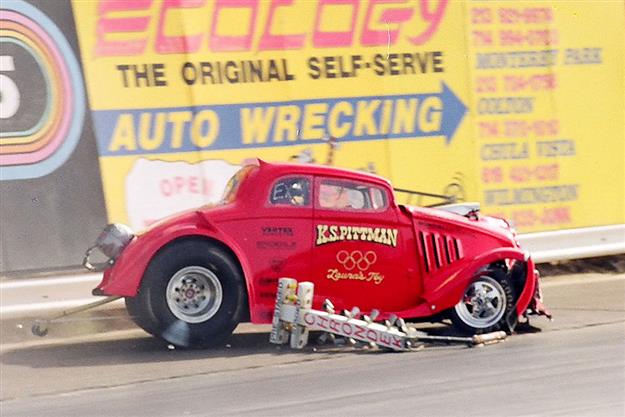 I’m still getting lots of mail about the Christmas Tree-smashing thread, with new suggestions for inclusion and even more photos, like the great sequence at right contributed by longtime NHRA Division 7 photographer and National Dragster contributor Bob Johnson, who caught gasser legend K.S. Pittman in one of the less-proud moments of his glorious career Jan. 1, 1992, when he tangled with the Tree at the Hangover Nationals at L.A. County Raceway near Palmdale, Calif. “Pittman was doing his burnout when he lost control, plowed the Tree, and eventually rolled the car over. Pittman was OK, but his car obviously was destroyed," he said.
I’m still getting lots of mail about the Christmas Tree-smashing thread, with new suggestions for inclusion and even more photos, like the great sequence at right contributed by longtime NHRA Division 7 photographer and National Dragster contributor Bob Johnson, who caught gasser legend K.S. Pittman in one of the less-proud moments of his glorious career Jan. 1, 1992, when he tangled with the Tree at the Hangover Nationals at L.A. County Raceway near Palmdale, Calif. “Pittman was doing his burnout when he lost control, plowed the Tree, and eventually rolled the car over. Pittman was OK, but his car obviously was destroyed," he said.
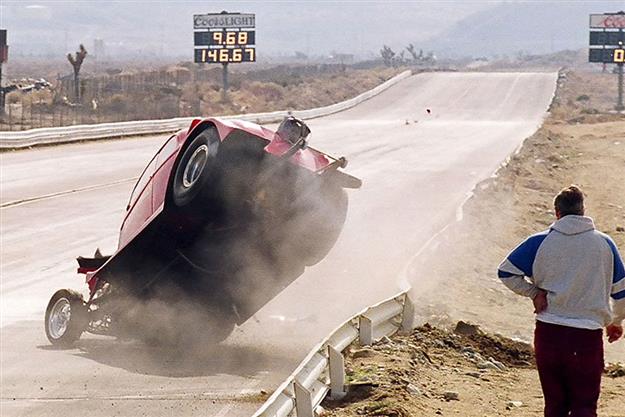 Although he sadly didn’t have photos to support his story, Brian Downey witnessed a unique chopping of the Christmas Tree in the late 1980s at an IHRA event in Rockingham, N.C., or, more likely, Darlington, S.C. “My dad was a crewman on Gary Litton’s Tennessee Shaker Funny Car, and I was an 8- or 9-year-old kid in heaven,” he remembered. “I normally rode in the tow vehicle but luckily was in the stands on this occasion. Gary was in the right lane. He did the long smoky burnout typical for the 1980s (before such things were thought to be unnecessary) and stopped a little short of half-track. The car had an issue getting into reverse, which I believe is a side effect of the long burnout. Gary revved the engine a little, and it finally went into reverse. He started to back up and gain speed rather quickly.
Although he sadly didn’t have photos to support his story, Brian Downey witnessed a unique chopping of the Christmas Tree in the late 1980s at an IHRA event in Rockingham, N.C., or, more likely, Darlington, S.C. “My dad was a crewman on Gary Litton’s Tennessee Shaker Funny Car, and I was an 8- or 9-year-old kid in heaven,” he remembered. “I normally rode in the tow vehicle but luckily was in the stands on this occasion. Gary was in the right lane. He did the long smoky burnout typical for the 1980s (before such things were thought to be unnecessary) and stopped a little short of half-track. The car had an issue getting into reverse, which I believe is a side effect of the long burnout. Gary revved the engine a little, and it finally went into reverse. He started to back up and gain speed rather quickly.
"At this point, I noticed something was wrong. I don’t remember if the brakes were out, throttle was hung, or if it was stuck in gear, but something was causing the car to back up faster than normal. The car mowed down the Tree along with the event signs. Then Gary spun the car around and into the guardrail. I still remember the car pushing against the guardrail, back wheels spinning, and crew guys furiously trying to stop the engine. No one was hurt, but the outcome could have been really bad had he not taken evasive action. Gary knew there were a lot of people behind the starting line. The longer burnout distance allowed him time to make a plan, which was turn into the guardrail when he saw the Tree, or hit it in this case.”
I also heard from jet dragster veteran Doug Brown, of Wildifire fame, about his memorable moment with the Christmas Tree at the 1983 Winternationals, which you can see in the video at right, beginning at about the 5:40 mark. (Thanks to Dave Wesolowski for the link!)
“My proud moment on ABC's Wide World of Sports!” Brown rejoiced. “Shirley [Muldowney] had just won Top Fuel. I beat Scott Hammack in his Smoke-N-Thunder jet in what I think was the last pair (ever) of jets to run at Pomona prior to them being banned. Great ABC coverage of the jets, then Buster Couch walking away from his position just as the Christmas Tree is blown over by the jet blast, showering Buster's back with broken glass. Too fun!”
That’s a pretty unique Tree toppling!
Still on the exhibition front, Bob Jarvi recalled seeing Bill “Maverick” Golden and the famed Little Red Wagon wheelstander wiping out the Tree at Minnesota Dragways in the late 1960s or early 1970s: “They had the Tree suspended with a cable across the starting line. He did his first wheelie/burnout and nailed the lights with the windshield/roof.”
Longtime reader Lou Kenkel gets a “close but no cigar” award but a valuable assist after sharing his memory from the 1976 U.S. Nationals, where Gary Burgin famously beat Don Prudhomme in the Funny Car final to hand “the Snake” his only loss of the season.

Jerry Ault had a close encounter with the Tree in the Modified final at Indy 1976.
|
 |
He wrote: “Both drivers were in the staging lanes ready for their turn to race, ‘the Snake’ in the right lane and Burgin in the left, when one of the remaining Sportsman-class cars, a Corvette as I recall, pulled a huge wheelstand and blew his engine, depositing oil and engine pieces all over the starting line in front of ‘the Snake,’ so much in fact that he lost control of his car in his own oil and besides trashing the starting line also knocked down the Xmas Tree. A massive cleanup and Tree repair took place, and ‘the Snake’ had to decide which lane he wanted and chose to stay in the right lane. This was obviously wrong on his part as he struck the tires at the hit, giving Burgin his biggest win ever and ruining his chances for a perfect season.”
Well, yeah, sorta. Except the Tree part and lane choice. What Kenkel is remembering is the Modified eliminator final in which Jerry Ault’s H/Gas Corvette – racing future Pro Stock pilot Don Coonce in Albert Clark’s C/Gas Corvette -- did indeed blow its engine but did not take out the Tree. Oil and water did get under his rear tires, and he did make a hard turn from the right lane across the centerline, but “Expert driving on Ault’s part kept him from hitting the Tree,” read the caption in National Dragster that week. The photos at right show how close he got to taking down the Tree. Oddly, all of that happened after the race had already been decided on Ault’s red-light start.
Both lanes were oiled to about the 100-foot mark, and, indeed, Prudhomme had lane choice based on his superior semifinal 6.15 (over Ron O’Donnell) compared to Burgin’s 6.21 (over Raymond Beadle). Prudhomme had run the left lane throughout the first three rounds but switched to the right for the final. He hazed the tires 50 feet in the run and lost the race and his winning streak, which had begun after the 1975 Indy race, where he had lost to Beadle.
 |
In an interview in National Dragster later that year, Prudhomme explained of his left-lane preference and his decision to go with the right in the final. "It was all my fault," he said. "I knew that some of the other guys were having trouble in that lane, but I thought that I could handle it. It was just one of those things."
So, here’s where the assist goes to Kenkel. As I was looking through the coverage from that event, I spotted the photo at right, which shows a car most definitely making contact with the Tree that year. If the Pinto looks familiar, it should, especially to Bob Glidden fans. No, it wasn’t Glidden behind the wheel, but rather Nashville, Tenn.’s Gene Turnage, who had purchased the Pinto – with which Glidden had won the Nationals in 1974 – and was running it in C/Gas when he took down the Tree during Modified class eliminations, the result of a reported broken rear axle.
Pro Stock history buffs may remember this as the event where Ford diehard Glidden was competing in a big-block Monza but failed to qualify, falling one spot short of the 8.97 bump with a 9.00 best. Cylinder-head damage throughout the weekend really hurt his chances and led to the first DNQ of his Pro Stock career. Glidden skipped the next event, the Fallnationals, but returned for the World Finals, back behind the wheel of his small-block Pinto, and reached the semifinals. The Indy boondoggle was an appropriate moment in one of his roughest seasons of the 1970s. He finished sixth that season after winning the championship in each of the preceding two years and would not fall outside the top five until 1993, with eight more championships between.
I also heard from both Dale Smith and E-town denizen “Berserko Bob” Doerrer regarding the Tree-smashing photos from Englishtown in the Sept. 20 column.
 |
“As soon as I opened up [that] installment, the first thought I had was of Camp Stanley taking out the Tree in his way-too-cool-totally-bitchin' blown alcohol Chevy Luv truck,” said Smith. “Then as I scroll down, you had it among your list. We had been living in Connecticut for about a year when we drove down to see the Wild Bunch at E-town. I just had to check them out and was there to witness the Tree getting demolished. Even better, they towed the truck back to the pits and made like a NASCAR pit stop, pounding out what they could of the damaged door and rocker panel, combined with a liberal application of duct tape. He made the next round, as a match racer only could.”
“I remember all of them as if they were yesterday,” Doerrer wrote. “I don’t remember who the B/A was, but I do remember that he offered to pay for all the damages, which he did. Camp Stanley whacked the Tree big time on a sideways burnout; they were called the Wild Bunch for a reason. That’s me in photo seven surveying the damage. Photo eight is the A/A of Bob LaRagina, who put an end to racing that day as we didn’t have enough parts to build another Tree. Vinny Napp decided right then and there that it wouldn’t happen again, so on Monday, he ordered three complete new Trees from Chrondek. I got to be pretty good at rebuilding damaged Trees and wiring up all the relays that controlled all the bulbs. I still have in my collection a vintage Chrondek Tree with just the stage bulbs, no pre-stage bulbs.”
 |
Doerrer’s mention of his vintage Tree makes a good segue to a sidebar of my history of the Christmas Tree. I was doing a little quick research for that other drag racing Phil – "Flying Phil" Elliott – on a 1970 Pro Stock race, digging through back issues trying to find the event in question when I stumbled on the photo at right in an August issue, showing a much different Tree than I’d ever seen.
This was not long after NHRA had announced that the season-ending Supernationals would be contested with a single-amber Pro start. The accompanying article explains that the so-called “instant green” Tree was nothing new and that it had been tried by NHRA in 1964, the year after the Christmas Tree was introduced in Indy.
According to the article, the Tree system was dubbed Matchmaker, and it really turned the whole Tree controversy upside down – literally. Two small staging lights (one for each lane) were at the bottom of the Tree, with single pairs of larger yellow, green, and red lights in ascending order up the Tree. The reasoning behind the design was that it allowed a driver’s eyes to travel upward and be at horizon level for the green, rather than looking down at the green bulb on the bottom of the original Tree design. The interval between yellow and green was set at two and a half seconds.
The first unit was built by then-Division 3 Director Bob Daniels for the total cost of $46.22, which included conduit tubing that could be screwed into an auto wheel and tire as shown, as opposed to the traditional crossed two-by-fours.
It was tested at events in Ohio, then used during qualifying at the 1964 Hot Rod Magazine meet in Riverside, Calif., where it met with mixed reviews. Many praised its simplicity, but the new spin on an already-new concept raised hackles, and the Tree was not used during eliminations, relegated to the corner of an NHRA storage room until the 1970 article.
![]()
 |
Of all of the Tree-chopping photos I posted, none garnered more attention than the photo of “Big John” Mazmanian’s Cuda sideways at Orange County Int’l Raceway going headfirst toward the Tree. I mentioned that not only did I not know whether the driver had collected the Tree, but even who the driver was because, even though it was a ’71 Cuda, it could have been any number of people in the car.
Don Hirsch was the first of many (as you will see) to respond, digging through his back issues of Drag Racing USA magazines to discover that the event was OCIR’s Big 4 Championships, and it was indeed Mazmanian’s nephew Rich Siroonian at the wheel. “The caption states he ‘took aim’ at the Tree but didn't hit it. The event was won by Bob McFarland’s Chevy II, and Rich was runner-up when he broke a coupler in the finals.”
Timothy Kral didn’t take the photo, but he might have been standing next to whoever did. “I had a press pass that day to take photos along the guardrail at OCIR. The driver was Siroonian, and he missed the Tree. I know this because he proceeded to cross into the opposing lane and come straight at me where I was positioned taking photos. I managed to take the photo of him coming at me before getting out of the way in case he impacted the guardrail in front of me. Rich managed to miss the guardrail as well and motored slowly on down the track. As I recall, this happened during qualifying.”
 |
As all of this was going on, I never thought to try to track down Siroonian himself and was saddened to learn that just days before the column was published, he had died. I wrote an obituary that ran in the NHRA.com Notebook but hadn’t acknowledged it here yet. I didn’t even have a chance to catch my breath when two days later we learned of the passing of Funny Car pioneer “Professor” Kelly Chadwick and two weeks later the death of 1960s Top Fuel star “Wild Bill” Alexander – the ol’ deaths-in-threes curse seemed to have struck us hard.
Reader Bill McLauchlan was another one who wrote and was certain that, even though his 717 permanent number was not visible in the photo, it was Siroonian driving and that he couldn’t possibly have hit the Tree.
“Back in the day, I would read National Dragster every week and am sure I’d remember if one of my favorite Funny Cars hit the Xmas Tree,” he wrote. “What I do remember is that Siroonian would drive his uncle John’s cars on and off. He drove the '68-'69 Cuda until the summer of ’69, when Dave Beebe drove the car (winning the PDA meet at OCIR), but Siroonian was back by Indy, fouling in the final to Mickey Thompson and Danny Ongais (Ongais would drive the ’72 car for ‘Big John’). When the ’70 Woody Cuda premiered, Wendell Shipman was driving, but Siroonian would eventually take over until Indy, at which time Arnie Behling was driving. Not for long, though, as Siroonian was back at the wheel as runner-up to Jake Johnston at the ‘70 OCIR Manufacturers Meet.
 |
“Only three guys drove the ’71 Woody car - Larry Reyes at the ’71 Winternationals (Siroonian drove the previous ’70 model at Pomona) in a one-race deal; Siroonian then drove it most of the year, including the Springnationals at Dallas as well as the PDA meet at OCIR; and Mike Snively drove it at the end of the season, including the ’71 Supernationals, where he runner-upped to Larry Arnold. All of this is from memory; however, what I never remember seeing is why Siroonian would come and go as the driver. I thought they were a cool team and always wondered why the changes? I was sad to see the note that he had passed away only a day or so before your column, so I guess it will remain a mystery.”
I also heard from Marie Delgadillo – dubbed "favorite fans" with husband Steve by Mazmanian’s wife back in the day – and knew it was her all-time favorite driver and unknowingly answered McLauchlan's question that “the family forced Rich to stop driving (stop this nonsense and get married was the order), which he resented and even drove a race for Mickey Thompson to show them!
“I don't believe they tagged the Tree on that run but do recall the announcer in the tower saying, ‘Mr. Mazmanian, I saw your name on both doors that run.’ We shared those memories both with ‘Big John’ and Rich Siroonian - bless them both!”
 |
I also wrote a brief obituary on Chadwick here and one for Alexander here, so I won’t rehash that info here, but I was thrilled to hear from “Wild Bill’s” daughter, Renee Alexander. According to her, his passing Oct. 5 was pretty sudden. He was hospitalized Oct. 3. The next day, doctors told Renee that it had spread to his liver and then his bones. “I told him I loved him,” she wrote. “His sister and granddaughters (son Rod's daughters) came by Saturday, and as soon as everyone left the hospital, he passed. The nurse on duty was holding his hand, so he wasn't alone. He was one tough dude. Never complained about his health. I spoke to him every day, sometimes twice or three times a day. We laughed every day when we talked, and he was always in good spirits. He was so proud and passionate about his racing, and I would like to do everything I can to keep his memory intact.”
And she did. In addition to creating a Facebook page in his memory, she put down some memories for me (and you all) to learn more about him. I was just 4 years old during his best season (1964), and he retired from driving the same year (1971) I attended my first race, so I never saw him drive. Alexander returned to the cockpit in the late 1980s in a nostalgia Top Fueler and won the March Meet at age 60. Renee got to see him race at both ends of his career but has something much more precious, four decades of time with him after that. This sport is all about family, about kids following in the footsteps of their parents, whether it’s to the grandstands or the cockpit, so I thought you’d enjoy her reminiscences.
 |
“Like most kids, my dad was larger than life to me as a kid. My earliest memories were with my dad at the racetrack. [My brother] Rod and I rode in the car that would be waiting behind him at the starting line, and we would watch him do his burnouts and then take off like a bullet. We intently watched the lights, then would race down the track as fast as the car would go to meet him at the end of his run to pick him up, all the way cheering ‘Go Dad, go.’ Rod and I were with him at the track most of the time, especially in the early days. I watched him with excitement race Ernie and Annie Alvarado’s Ernie’s Camera entry. We watched him race the Sbarbaro car and the Wishart car. And I watched the ladies clamor for a picture of my dad. I curiously wondered why.
[Roger Lee also created a nice Facebook tribute to Alexander, which you can find here.]
“I listened to my dad talk shop and use words about engines and parts I didn’t know or understand, but I could always hear the passion in his voice. And that made me happy. Dad would let me hang out with him in the garage, and I would watch him work. He would ask me for a tool or a beer, just as long as I didn’t talk or ask questions ... LOL.
“As a kid, I asked my dad why he liked racing, but he never gave me an answer. As an adult, I kinda let it go. He never changed his love for the racing community. It’s a trait that I’ve grown to respect, admire, and honor.
“You knew where you stood with my dad. If he liked you, he was gentle and kind. If he didn’t like you or respect you, he turned his back and wouldn’t have anything to do with you. There was no phony BS with him. He would tell you his honest truth. No mincing of words.
"He took me to work on Saturdays, where I would quietly watch him arc weld, or grind metal parts, fiery sparks flying everywhere like some kind of magical being wielding a magic torch.
“My dad was not a boastful guy. I never heard him brag about his racing or brag about any race he won. He always knew it was a team effort. This racing life was all I knew. I thought all dads raced or were like my dad.
 |
“I do remember very vividly my dad’s crash in 1963. I remember the horror of seeing him in the hospital. So I really worried every time he raced. Rod and I grew up at the races with the noise and the rubber smell and the excitement. We grew up in the pits at the drags. And I remember dad pacing and being very quiet before a race.
“He went to work every day no matter how he felt. When Toni (our mother) left him without warning, he had the burden of raising two teenagers alone and grieving the loss of his wife who left him for another. It was painful to see him so sad. But he did find love again.
“My dad lived and breathed racing. He loved his racing friends. When I visited him in the hospital after he was assaulted a few years ago, he asked only for his racing friends. He had a great sense of humor and blended his humor with his unique insight and wit. He laughed and made me laugh every day.
“He was dedicated to his craft, and nothing would stand in his way of racing. He knew he wasn’t the best father. He held strong to his beliefs and his character. But he could also admit to his shortcomings and mistakes. I know he was not perfect, but he was my dad. He loved his son, Rod, and his sister Sandy, who has been there for him through all his ups and downs. He loved Rod’s daughters, Brandi and Kristi, from whom he had occasional visits.
“As for my relationship with my dad, I spoke to him every day after my brother passed away. I called sometimes three times a day. Dad cared about what was important to me. He never complained about much of anything. And each time we talked, he wanted to know how my kitty was doing. I would share the kitty anecdotes of the day, and he would laugh heartily. Whenever I thought I had outsmarted my cat, Dad would say, ‘He’s just retraining you.’ He had an amusing way of describing the world around him.
“I told him I loved him often. When I spoke to him on Friday the 4th, I told him I would be coming to the hospital, and he emphatically told me, ‘Don’t bring kitty.’ In the end, he was very brave and never showed any fear. He told me not to worry about him. I held his hand and told him I loved him.
“He indirectly taught me the importance of accepting others for who they are and the importance of compassion and forgiveness.
“He really didn’t look to tomorrow. I’d say, ‘Dad do you need food?’ or ‘Why don’t you let me get you some groceries?’ He would reply, ‘I’ve got food for two days, and I don’t want to rush into anything.’ And we would both laugh. Of course, that reply frustrated me because I wanted him to have everything he needed, but I respected his wishes. I had a cleaning lady come and clean his house once a week so his house was clean. He slept in clean sheets. And he had clean clothes. He had his TV, and he was able to stay in his house up until Thursday, which is what he wanted. I only wish he had more calls from friends. But I know life happens.”
![]()
 |
Wow, I don’t even know where to begin with something as touching as Renee's letter, the powerful love between a father and child. It’s probably the way that most parents hope their children will remember them and also a powerful motivator for any kid with an aging or sick parent. I lost my dad when I was 9 but found a wonderful father figure in the man my mom married after their divorce. That's him at right, trying out the cockpit of the John Force Funny Car at the NHRA Motorsports Museum last year.
He has not been in good health (he’s 83 and still smokes despite warnings from his doctor), and just a few weeks ago, I answered a call from my mom, and I could tell in her voice that something bad had happened to him. They’re divorced now, but she still is there for his every bad turn, and I always knew that the bad word would one day come from her.
He was riding with a friend to get supplies to fix his well – despite his ails and age, he’s still a hands-on kind of guy – when a steering component broke in the truck in which they were riding. They plunged off the side of the road and into some trees. He was badly hurt, but the tough old bastard that he is, he survived. Broken nose, broken ribs, bruises covering his entire body, but he lived.
I’ve never been shy about telling him how much he has meant to me as a fatherless young lad, but I made sure he knew it again the first time we talked during his recovery. Do that today with your loved ones.
Thanks, as always, for reading and contributing. I'll see you next Friday.





